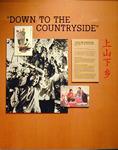
History of Cultural Revolution
Right to Rebel
On the Road
Living
Culture
Daily Life
Learning
The Countryside
Looking Back
Sidney Rittenberg Presentation
Links
 > View Large < |
"UP TO THE MOUNTAINS AND "I don't regret going to the countryside." -- Shanghai businessman "We wanted to go the areas with the most hardship. We got to see the poverty and hard work of the countryside...things that can't be found in books.... We went willingly, but we were too naive...things weren't as simple as we thought." -- Nanjing factorywoman |
CALMING THE CITIES
At first, the Cultural Revolution aimed to "attack with the pen, only defend with the gun." But by 1968, especially in the cities, different Red Guard factions were fighting one another with weapons instead of words.
EQUALITY OF CITY AND COUNTRYSIDE
Chinese cities have always been more prosperous than the countryside. Mao wanted to reduce Red Guard violence in the cities, and toughen "spoiled" urban youth. He started a new phase of the Cultural Revolution. Educated youth would go to the villages, where they would learn from the "poor and lower-middle peasants." Students went "up to the mountains and down to the countryside." Most students enthusiastically volunteered to go, although refusal was not an option. Millions of city youth resettled in the countryside. They did not return to the cities until after Mao's death in 1976.
This page
last updated
September 26, 2002
All material © 1998-2002
Burke Museum of Natural History & Culture
University of Washington, Box 353010
Seattle, WA 98195
This site best viewed at 800 x 600
using IE 5.0 or above.
